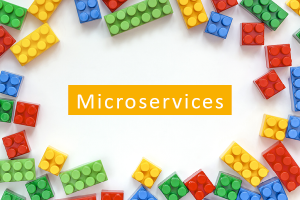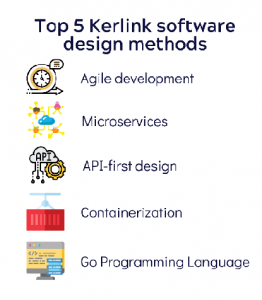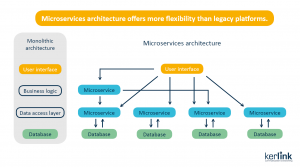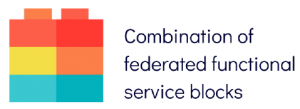The untold story: how Kerlink’s mastery of software-development best practices delivers critical benefits to customers. Part 2, Microservices

By Stephane Dejean – Kerlink CMO
Part 2 of our five-part series explains how microservice-based designs support modern, flexible and scalable architectures in LoRaWAN IoT networks
Kerlink is widely recognized for its highly reliable connected hardware, including its well-established Wirma or Wirtrack product range, and for the quality, robustness and all-around performance of its Wirnet LoRaWAN network-infrastructure solutions. Kerlink was the first provider of commercial, carrier-grade gateways and recently extended its premier industrial-grade iSeries with new indoor and outdoor products.
As a full-service, turnkey Internet of Things (IoT) solutions provider, the company also offers proven quality software development. With particular expertise in network management, orchestration solutions and value-added services such as geolocation and remote device management, Kerlink has more than 120,000 installations with more than 330 clients in 69 countries. The quality of its software is increasingly being recognized by demanding and experienced industrial users.
The selection, adoption and mastery of software-development best practices drive Kerlink’s business model and the richness of its service portfolio.
Not only are these IoT solutions perfectly synchronized with the latest LoRaWAN specifications, they also leverage the flexible, efficient and open methods of software design and management to meet the scalability, security and usability requirements of Kerlink’s customers worldwide.

The series:
- Method 1: Agile Development – March 19
- Method 2: Microservices – March 26
- Method 3: API-first Design – April 2
- Method 4: Containerization – April 9
- Method 5: Go Programming Language and Direct Benefits to Customers – April 16
In this five-part series, we will explain our top software design & development methods that benefit our customers and show that the company is at the forefront of software design, development methods and architectures.
Part 2: Microservices
Microservices break down large, unmanageable applications and platforms into a set of loosely coupled services and distinct processes that can be applied together or used as independent services and redeployed elsewhere.

Our microservice-based design offers customers a modern, flexible and scalable architecture. Here are three major characteristics of microservices:

Each functional service block is individualized and developed separately to ensure its functional consistency and software integrity. This approach increases the quality of software developed since only one service block will be tested at a time.
Each functional service block identified can operate either autonomously or be integrated into a complete software and functional suite. For example, Kerlink’s independent service blocks can be combined with other software packages available on the market, including Kerlink’s LoRaWAN Network Server (LNS), network management tools, geolocation-application and device- management software. Our service blocks can be integrated into complete software packages, including Kerlink’s Wanesy Management Center core network, provisioning, monitoring and orchestration suite.


Individual microservices are federated, meaning each has its own data model and data stores. This allows enterprises greater flexibility, reduces complexity and facilitates scalability across the technology environment.
This microservices-based architecture allows companies to design an open and flexible architecture, eliminating silos and building teams that can effectively work cross functionally.
This openness is an important Kerlink differentiator and illustrates the company’s commitment to proactively support an open ecosystem of partners.
Our approach also guarantees customers long-term scalability and interoperability, the ability to combine solutions available on the market and the possibility to freely switch to Kerlink solutions by creating a relatively simple middleware module between Kerlink and third-party APIs using published interfaces. All of these benefits ensure that customers can evolve their solutions and architectures easily.
Hardware & software that ensure interoperability throughout the IoT chain
The choices made in Kerlink’s methods, architectures and support tools illustrate the company’s maturity and innovation in software design, deployment management and operations management in highly demanding customer environments. Kerlink believes in providing open, interoperable and reversible solutions matched to industry standards to provide exceptional customer experience and ensure the ongoing development of its solutions to support customers’ growing and evolving businesses.
Kerlink’s hardware and software expertise ensures interoperability of all functional components of the IoT chain, including embedded gateway software and server-side applications. Customers have come to rely on Kerlink’s expertise in the design of infrastructure and applications to support IoT network management and low-power wide-area (LPWA) private and public networks, in particular.
Continuous production releases
Kerlink’s choice of agile development, microservices architecture, API-first design, containerization and Go programming language has strengthened Kerlink’s IoT solution-development efforts. And we have shared these benefits with our valued customers by providing the ability to deploy a Kerlink solution in minutes, minimize risks throughout IoT solution-operations management, control IoT solution costs at a refined level and decrease deployment time.
By allowing continuous production releases, Kerlink enables its customers to benefit from rapid advancements in applications, management tools and platforms. These advancements improve the speed at which enterprises can design, deploy and support their IoT solutions. A software-design framework allows Kerlink to develop a set of automated operations tools to foster fast, reliable and flexible delivery of solutions for its customers.
Next week: API-first design


